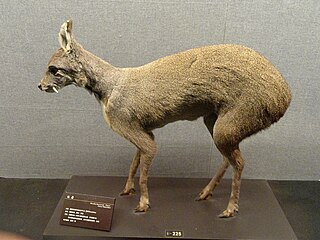
Coccidia (Coccidiasina) are a subclass of microscopic, spore-forming, single-celled obligate intracellular parasites belonging to the apicomplexan class Conoidasida. As obligate intracellular parasites, they must live and reproduce within an animal cell. Coccidian parasites infect the intestinal tracts of animals, and are the largest group of apicomplexan protozoa.
Coccidiosis is a parasitic disease of the intestinal tract of animals caused by coccidian protozoa. The disease spreads from one animal to another by contact with infected feces or ingestion of infected tissue. Diarrhea, which may become bloody in severe cases, is the primary symptom. Most animals infected with coccidia are asymptomatic, but young or immunocompromised animals may suffer severe symptoms and death.
Eimeria acervulina is a species of Eimeria that causes coccidiosis in poultry worldwide. Affected birds tend to appear depressed with reduced appetite, diarrhea, and depigmentation. Diagnosis is made by necropsy based on lesions in the upper third of the small intestine, and the appearance of white or grey striations along the intestinal mucosa. Scrapings of the mucosa from diseased birds can reveal oocysts.

Eimeria tenella is a species of Eimeria that causes hemorrhagic cecal coccidiosis in young poultry. It is found worldwide.

Eimeria is a genus of apicomplexan parasites that includes various species capable of causing the disease coccidiosis in animals such as cattle, poultry and smaller ruminants including sheep and goats. Eimeria species are considered to be monoxenous because the life cycle is completed within a single host, and stenoxenous because they tend to be host specific, although a number of exceptions have been identified. Species of this genus infect a wide variety of hosts. Thirty-one species are known to occur in bats (Chiroptera), two in turtles, and 130 named species infect fish. Two species infect seals. Five species infect llamas and alpacas: E. alpacae, E. ivitaensis, E. lamae, E. macusaniensis, and E. punonensis. A number of species infect rodents, including E. couesii, E. kinsellai, E. palustris, E. ojastii and E. oryzomysi. Others infect poultry, rabbits and cattle. For full species list, see below.
Poultry diseases occur in poultry, which are domesticated birds kept for their meat, eggs or feathers. Poultry species include the chicken, turkey, duck, goose and ostrich.

Eimeria maxima is a protozoan that causes coccidiosis in poultry. It is located in the middle part of the intestine, on either side of Meckel's diverticulum, and frequently ascends into the duodenum. The lesions it causes are limited to the middle of the small intestine.
Eimeria stiedae is a species of Eimeria that causes hepatic coccidiosis in rabbits. It was observed for the first time by Antonie van Leeuwenhoek in 1674.
Eimeria necatrix is a species of Eimeria that causes very severe intestinal coccidiosis in older poultry characterized by congestion, hemorrhage, necrosis of the intestine and bloody feces. Very large schizonts can be seen as white or yellow dots and oocysts can be found occasionally in the ceca.
Eimeria meleagridis is a species of coccidia found worldwide, which causes mild disease in young turkeys aged 4–8 weeks. The parasite causes disease in the cecum, where, on post-mortem examination (necropsy), a cream-colored exudate is seen.

The dwarf musk deer or Chinese forest musk deer is an artiodactyl native to southern and central China and northernmost Vietnam. The species name is after the collector Mikhail Mikhailovich Berezovsky. On June 14, 1976, China entered the dwarf musk deer onto its endangered species list. Four subspecies are recognized:

Dinitolmide is a fodder additive for poultry, used to prevent coccidiosis infections. It is sold under trade names such as Coccidine A, Coccidot, and Zoamix.

Sulfadimethoxine is a long-lasting sulfonamide antimicrobial medication used in veterinary medicine. It is used to treat many infections, including respiratory, urinary tract, enteric, and soft tissue infections and can be given as a standalone or combined with ormetoprim to broaden the target range. Like all sulfamides, sulfadimethoxine inhibits bacterial synthesis of folic acid by acting as a competitive inhibitor against PABA. It is the most common drug prescribed to dogs who have coccidiosis.
Eimeria fraterculae is a species of alveolates belonging to the family Eimeriidae. It causes renal coccidiosis in the Atlantic puffin.
Robenidine is a coccidiostat. Robenidine is an antibiotic used for the control of coccidiosis, a debilitating protozoal infection in poultry. Although there are alternative antibiotics available, robenidine is important in the management of antibiotic resistance as farmers rotate the use of robenidine with other antibiotics to try to preserve the effectiveness of these products in fighting infections.

Pediococcus acidilactici is a species of Gram-positive cocci that is often found in pairs or tetrads. P. acidilactici is a homofermentative bacterium that can grow in a wide range of pH, temperature, and osmotic pressure, therefore being able to colonize the digestive tract. It has emerged as a potential probiotic that has shown promising results in animal and human experiments, though some of the results are limited. They are commonly found in fermented vegetables, fermented dairy products, and meat.
Eimeria zuernii is a species of the parasite Eimeria that causes diarrheic disease known as eimeriosis in cattle, and mainly affects younger animals. The disease is also commonly referred to as coccidiosis. The parasite can be found in cattle around the globe.
Eimeria arlongi is a species of Eimeria that causes clinical coccidiosis in goats. It and Eimeria ninakohlyakimovae are two of the most pathogenic species for goats. It is particularly prevalent in goat kids in Iran. Issues with coccidiosis specifically due to Eimeria arloingi have also been reported in Egypt and Portugal. It is unclear whether this species is present in the Americas as most of the case reports of coccidiosis in these areas do not differentiate the species causing the disease. Infections with this species are commonly compounded by infections with other Eimeria species in "mixed infections." This species is closely related to Eimeria bovis and Eimeria zuernii which are both highly pathogenic in cattle' Infections with this species are characterized by lesions specifically in the jejunum, but also the ilium and cecum which results in diarrhea. Oocysts begin shedding between 16 and 18 days after the animal is infected which is when the parasite is spread. The shedding can last as long as 15 days. This parasite causes an immune response in its host that includes accumulation of fluid in body cavities, presence of large numbers of leukocytes in the small intestine, and necrosis of the tissue of the small intestine. Pale yellow plaques can be seen on the small intestine of severely affected kids at necropsy.
Eimeria bovis is a parasite belonging to the genus Eimeria and is found globally. The pathogen can cause a diarrheic disease in cattle referred to as either eimeriosis or coccidiosis. The infection predominantly cause disease in younger animals.

The Houghton Poultry Research Station was a poultry disease research station in northern Cambridgeshire.








